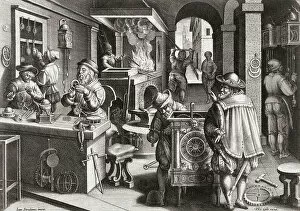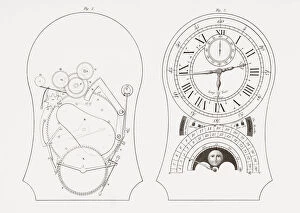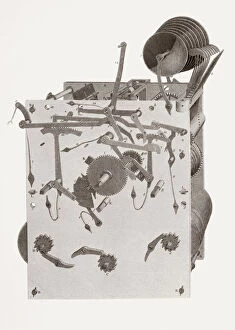Clockmaking Collection
Clockmaking in Holland during the late 16th century was a flourishing industry
All Professionally Made to Order for Quick Shipping
Clockmaking in Holland during the late 16th century was a flourishing industry, with skilled artisans crafting intricate timepieces that were both functional and beautiful. The clockmakers of this era were known for their precision and attention to detail, creating masterpieces that stood the test of time. One notable engraving from this period depicts "The Clockmaker, " showcasing the expertise and craftsmanship required to create these mechanical wonders. The image captures the interior of a clockmaker's shop, revealing a world filled with tools and instruments used in the creation process. In another fascinating illustration, four different remontoire escapement systems are showcased by renowned clock makers such as De Lafon, Massey, Mendham, and Prior. This display highlights the diversity of techniques employed by these talented individuals to ensure accurate timekeeping. Equally impressive is an equation clock created by Enderlin. This innovative piece demonstrates how clockmakers pushed boundaries by incorporating complex mathematical calculations into their designs. Tools used in clockmaking during the 18th and 19th centuries are also depicted in an intriguing image. These antique instruments serve as a testament to the ingenuity and resourcefulness of early craftsmen who relied on manual labor to bring their creations to life. Musical watches were another specialty within this trade, exemplified by Clockmaker Recordon's masterpiece featured in one engraving. These exquisite timepieces not only kept track of hours but also delighted listeners with melodious tunes emanating from within. A particularly remarkable illustration showcases eight different escapement systems devised by distinguished clock makers like Berthoud, Smeaton, De Bethune, Amant, Harrison, Cumming Mudge, and Peter Le Roy. Each system represents a unique approach towards achieving accuracy while maintaining reliability—a testament to innovation within this field. Dial work was yet another aspect where creativity flourished; clocks displaying moons' age phases became popular among collectors seeking celestial beauty alongside precise functionality. Lastly, a thirty-hour clock with alarm and count wheel striking work is depicted.
































